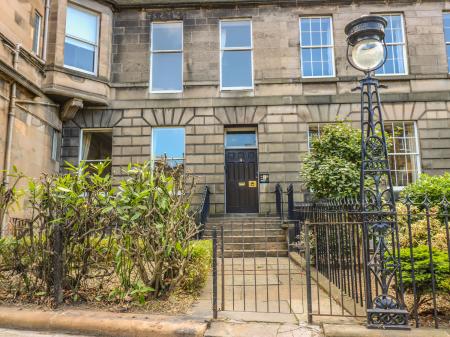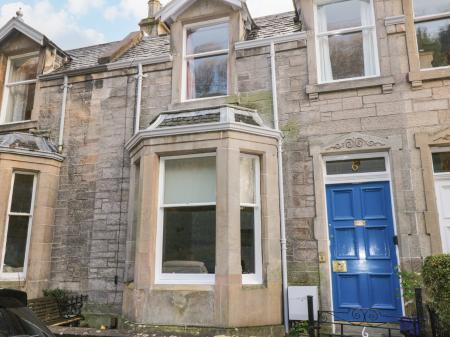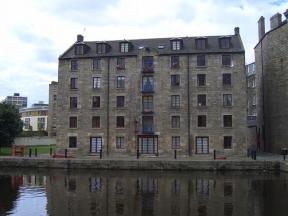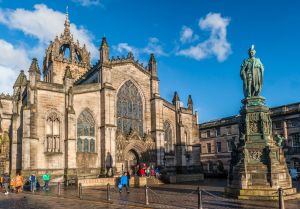
History
The origins of St Giles are lost in the mist of time. The oldest features are traditionally said to be 4 large pillars, said to date to 1124 but there may have been a church on or near this spot since AD 854. The church may have been in use for years without being formally dedicated, and it was not until 1243 that the Bishop of St Andrews finally dedicated the church. It was only later that the church was rededicated to St Giles. It is possible that the French saint was chosen as a sign of the close historical links between Scotland and France.The church was damaged in a fire in 1385 but rebuilt and extended with guild chapels, chantries, and a chapel set up to hold a relic of St Giles. Due to the proliferation of chapels, by the mid-16th century there were roughly 50 separate altars in the church!
John Knox and the Reformation
The 16th century was a time of religious turmoil in Scotland. Reformers, led by John Knox, attempted to change the style of worship and church administration. In 1559 John Knox, who was born near Edinburgh, marched into the town at the head of the Lords of the Congregation. He was elected Minister of St Giles, a role he was to hold for the next 13 years. It seems that religious transformation passed with relatively little upheaval in Edinburgh; there were no riots or looting, and very little of the stained glass destroyed, at least at first.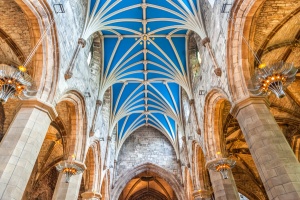
Mary, Queen of Scots may have attended Parliament here. but it is likely she never came to a Reformed service of worship. Her half-brother, the Earl of Moray, became Regent after she abdicated. The Earl was a friend of Knox, and after he was assassinated, Knox preached at his funeral. A brass plaque marks the location of Moray's tomb in the Holy Blood Aisle.
Jenny Geddes
When Charles I tried to introduce Scottish Episcopal bishops and Archbishop Laud published a new Anglican prayer book along episcopal lines. It is during this period that St Giles was first named a cathedral. The moves by Charles I led to perhaps the most famous episode in the history of St Giles.In 1637 the Dean of St Giles tried to hold a service using the new prayer book. A local woman named Jenny Geddes, a street-seller, was so enraged that she hurled her folding stool at the Dean's head and cried out, 'De'il gie you colic, the wame o’ ye, fause thief; daur ye say Mass in my lug?" meaning loosely "Devil give you colic, false thief; dare you say the Mass in my ear?'. The episode of hurling the stool may have been a Victorian invention, but there was certainly an outbreak of protests.
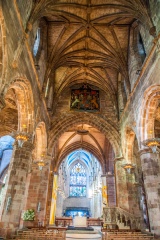
Montrose and Argyll
Those protests led in time to the National Covenant, declaring Scotland's religious independence. The National Covenant is on display in the Preston Aisle. Two signatories to the National Covenant were Archibald Campbell, Marquess of Argyll, and James Graham, Marquess of Montrose. Both men claimed to be loyal to the king, but they were at odds over how to implement religious reform. Argyll's reformers forced people to sign the Covenant, and Montrose raised an army to combat the reformers' excesses.Montrose was captured and executed outside St Giles in 1650. His head was placed on a spike outside the church, but when Charles II was restored to the throne in 1660 his body was exhumed and reburied inside the church. His tomb is in the Chapman Aisle. As for Argyll, he only survived the Restoration by a year and was himself executed in 1661. His memorial is in St Eloi's Aisle. It is strange to see the tombs of the 2 enemies so close together within the same church.
The church was heavily restored in the 19th century; chapels were puled down, partitions removed, and the exterior of the building encased in ashlar. New stained glass was inserted, and today the Victorian glass is one of the cathedral's great treasures. One of the best windows is at the west end, designed by Pre-Raphaelite master Edward Burne-Jones and made by the William Morris works. More modern is the large west window, celebrating the life of poet Robert Burns. Another window commemorates author Robert Louis Stevenson.
One of the most recent additions to the cathedral is one of its best features. The Thistle Chapel was designed by architect Sir Robert Lorimer in 1911. The chapel is home to the Knights of the Thistle, Scotland's equivalent to the Order of the Garter in England. The chapel is designed in high Gothic, with richly coloured heraldic symbols and intricately carved details.
There are fragments of medieval stonework, most from the later medieval period, after the fire of 1385. Near the cathedral shop is a grotesque stone corbel head, and in the Albany Aisle are early 15th century heraldic carvings.
When is a cathedral not a cathedral?
The history of St Giles is tangled around the Byzantine convolutions of religious reform. During the Middle Ages Edinburgh had no cathedral, for the royal burgh was part of the Diocese of St Andrews, and the Bishop made his 'cathedra', or seat, at St David's Cathedral in St Andrews.St Giles was only actually a cathedral for 2 short periods in its history, from 1635-38 and 1661-89, during the period when episcopalianism within the Kirk of Scotland briefly enjoyed royal favour. Since the Reformation the Church of Scotland has not used the term cathedral, so the name is something of an anachronism.
The cathedral is open daily except at Christmas and New Years (see the official website for details) and is free to enter, though a donation is requested.






 We've 'tagged' this attraction information to help you find related historic attractions and learn more about major time periods mentioned.
We've 'tagged' this attraction information to help you find related historic attractions and learn more about major time periods mentioned.